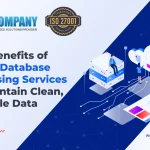In today’s digital age, organizations increasingly rely on web application development to fuel growth, increase efficiency, and provide excellent user experiences. As a business owner or CEO, you must comprehend the notion of web apps and how they may assist your corporation. In this topic, we will offer an introduction to web apps, emphasizing their relevance as income producers for enterprises.
A web application is a software program that is accessed via a web browser and allows users to interact with it via the internet. Web applications are dynamic, interactive, and frequently adapted to specific user needs.
So, why should business owners and CEOs be concerned about online applications? Web apps allow businesses to reach a larger audience by allowing access from any device with an internet connection.
We shall look at several areas of web application development in this post. Whether you intend to create a new web application or improve an existing one. Understanding the fundamentals and best practices of web application development will be quite beneficial.
By the conclusion of this essay, you will have a basic grasp of web application development as well as the stages required in creating and deploying successful web apps. You will be prepared to make educated judgments and work successfully with development teams to propel your company ahead.
Table of Contents
ToggleWhat is a Web Application?
A web application is a software program that runs on a web server and is accessible via a web browser. Web apps are dynamic and interactive, allowing users to perform specified activities, enter data, and obtain customized outputs. They take advantage of contemporary web technologies such as HTML, CSS, and JavaScript to provide rich user experiences and real-time data processing.
Difference Between Web Application and Website
A website and a web application are two distinct concepts that are sometimes used interchangeably, although they are not synonymous. A website is a collection of web pages housed on a single domain name that is meant to deliver information to visitors. Websites can be static or dynamic, but their primary purpose is to convey content. HTML, CSS, and JavaScript are commonly used to create websites.
Web Application Advantages for Businesses
Web apps provide various advantages for enterprises. For starters, online apps are easily accessible. Users with an internet connection can access web apps from any device, including a desktop computer, laptop, tablet, or smartphone. This adaptability enables firms to reach a broader audience and cater to an increasing number of mobile users.
Web applications also provide real-time data processing and synchronization. One user’s changes are quickly replicated across all devices and sessions, enabling data consistency and cooperation.
Additionally, web apps allow for personalization and modification. By collecting user data and preferences, businesses may give tailored content, suggestions, and user experiences. This degree of personalization boosts user engagement and promotes conversions and customer loyalty.
Web apps have evolved into an important component of current company strategies. They provide improved interaction, real-time data processing, access, and customized user experiences. Understanding the varied benefits of web apps is critical for business owners and CEOs wishing to use this technology to boost revenue and distinguish their businesses.
Types of Web Applications
Client-side web applications, server-side web applications, and hybrid web applications are the three basic types of web applications. Each variety has its own set of qualities, benefits, and considerations.
- Client-side Web apps: As the name implies, client-side web apps process and function largely through the user’s web browser. They’re made with web technologies including HTML, CSS, and JavaScript. All processing and rendering occur on the client side (the user’s browser) when a user interacts with a client-based web application. The responsiveness and interactivity of these programs are well-known.
- Server-side Web apps: These apps process data on the server and give the results to the user’s browser. They are usually created with server-side programming languages such as Python, Ruby, or PHP.
- Server-side web applications: It may handle complicated business logic and database activities. They provide scalability and maintainability since the essential processing occurs on the server, decreasing the strain on the client side.
How Web Applications Work in a Browser
When you engage with a web application, whether it’s a simple form submission or a complicated data-driven job, several activities occur behind the scenes. These operations entail collaboration between the client and the server that hosts the web application. Let’s look at the essential components and stages involved in the operation of web apps.
- The Client-Server Model: Web applications use the client-server model. The client is your web browser, while the server is the computer that hosts the online application. The client sends requests to the server, which conducts the necessary activities and returns the relevant replies. This connection is at the heart of how web apps work.
- The Request-Response Cycle: When you interact with a web application, your browser sends a request to the server for a certain web page or capability. This request comprises information such as the kind of request (GET, POST, etc.), any data being sent, and other pertinent metadata. The server processes the request, takes the relevant actions, obtains data from databases or external APIs as needed, and generates a response.
- Components of the Front-End and Back-End: Web applications are made up of two major parts: the front-end and the back-end. The user interface that you interact with in your web browser is included in the front end, also known as the client side. HTML markup is used for structure, CSS styles are used for display, and JavaScript is used for interaction.
- Rendering and Displaying: After the server delivers the response back to the client (your browser), the browser analyzes the data and displays it as a web page. To show the material aesthetically appealingly, the browser uses HTML markup and CSS styling. If the web application has dynamic parts, JavaScript will change the HTML and update the user interface as needed.
Case Studies of Successful Web Applications:
We will look at real-world case studies of successful web apps that have had a substantial influence on their respective sectors in this topic. We may learn a lot from these examples about the methods, approaches, and lessons gained that contributed to their success.
Airbnb: Airbnb transformed the hospitality business by allowing homeowners to rent out their houses. Airbnb constantly enhanced its web application by incorporating user input and optimizing the user experience using an iterative method.
Slack: It is a collaboration and communication platform that began as an internal tool and has since expanded into a widely used online service. Slack improved its services and designed an easy-to-use interface for organizations of all sizes.S lack has established itself as a market leader in team communication.
Trello: Trello, a web-based project management application, has grown in popularity owing to its ease of use and adaptability. Trello has an iterative approach to development, progressively adding features based on user input, with a focus on improving collaboration and visualizing processes.
Canva: Canva used an iterative development process, continually developing its features and taking user feedback into account. Canva was able to achieve a market fit and attract millions of users globally.
In the next section, we will look at the process of creating a web application, offering step-by-step guidance that will take you from the first concept to a successful launch. Understanding this approach will provide you with the information and resources you need to plan, execute, and iterate on your web application projects efficiently.
The Web Application Development Methodology
Creating a web application needs meticulous planning, execution, and an iterative approach. We will bring you t step-by-step guidance on how to construct a web application on this topic. We will also discuss the significance of adopting and modifying an agile approach to meet your requirements while preserving speed and agility.
Define Your Goals and Scope: Begin by clearly outlining the goals and scope of your web application. Understanding your target audience, identifying the essential functionalities, and outlining the needed features are all important steps. The entire development process will be guided by establishing a clear vision.
Design and planning: Make a detailed strategy and design for your online application. Wireframing the user interface, producing mockups, and sketching out the user flow are all part of this process. Take into account usability, accessibility, and overall user experience.
Adopt an Agile Development Methodology: Agile development approaches like Scrum or Kanban give a foundation for iterative and flexible development. Break the project down into smaller tasks, prioritize them, and complete them in short iterations or sprints.
Create the Front-End: Begin by creating the front end of your web application. Create the user interface and add the needed functionality using HTML, CSS, and JavaScript. Ascertain that the front-end design is responsive and optimized for various devices and screen sizes.
Build the Back-End: Work on the back-end of your web application at the same time. Set up the necessary infrastructure and choose a suitable server-side programming language, such as Python, Ruby, or PHP. Business logic, data management, and connections with other services or APIs must all be implemented.
Frameworks for App Development:
Using the correct development frameworks while constructing a web application may substantially speed up the process and give a solid basis for your project. In this article, we will look at various prominent frameworks, each with its own set of benefits and features.
- Node.js/React/Express: Node.js is an extremely capable JavaScript runtime that enables server-side programming. They constitute a robust MVC (Model-View-Controller) framework stack when combined with Express.js, a simple online application framework.
- Laravel: It is a powerful PHP framework noted for its beauty and simplicity. It adheres to the MVC architectural pattern and provides a plethora of capabilities to help expedite web application development. Laravel has a simple and expressive syntax, built-in authentication and authorization systems, database administration tools, caching, and routing features, and it is lightweight.
Stages of App Development:
The first stage is to develop your web application concept and outline your aims and objectives. Conduct market research to find prospective consumers, evaluate competitors, and verify your proposal.
Development of a Minimum Viable Product (MVP): The objective is to create a functional prototype to launch and test with actual users. This method enables you to collect useful input, confirm assumptions, and make educated decisions regarding the path of your product.
Agile Development and Iteration: Review and prioritize features regularly respond to customer input, and iterate on the product to improve its functionality and user experience. Agile development encourages adaptation, flexibility, and constant improvement.
Scalability and performance optimization: As your online application grows, pay attention to performance and scalability. Optimize your code, reduce loading times, and make sure your app can manage rising traffic and user needs. Key performance data should be monitored and analyzed to detect bottlenecks and improve the user experience. Scalability is critical for accommodating expansion and properly handling increased user traffic.
Conclusion:
In today’s fast-paced digital landscape, developing web applications that deliver exceptional user experiences and drive business success is essential. As a technology-driven company dedicated to bringing applications to life, IT Company is a reliable partner for your web application development needs.
Contact IT Company today and let us bring your web application development ideas to life, making a meaningful impact on your business and customers.







